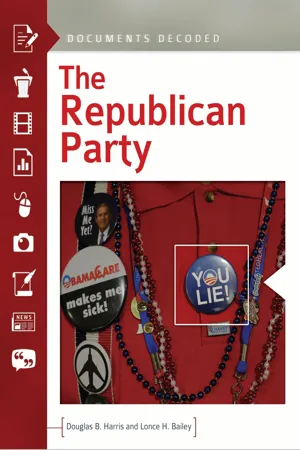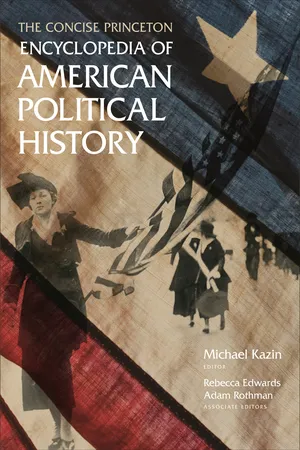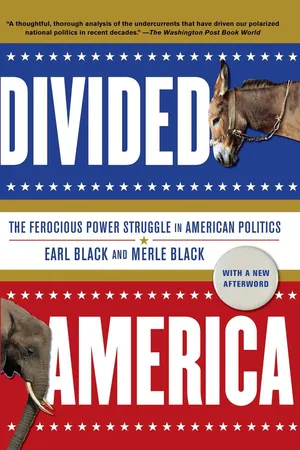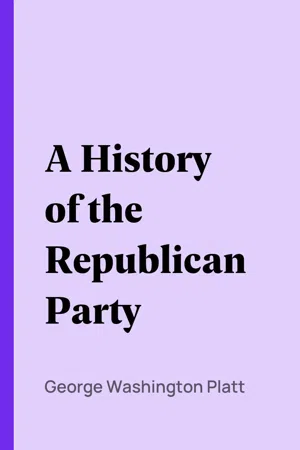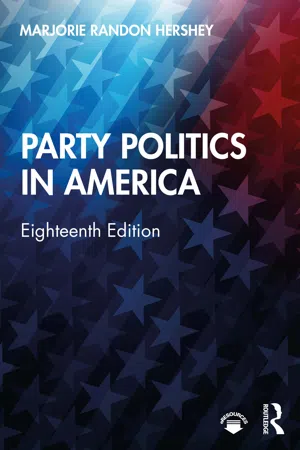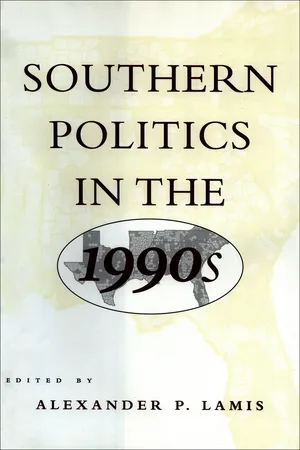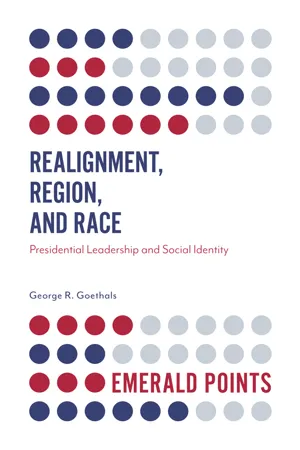History
Republican Party Civil War
The Republican Party Civil War refers to the internal conflict within the Republican Party in the United States, particularly during the Trump era. It involved a struggle between traditional establishment Republicans and the more populist, nationalist faction aligned with former President Donald Trump. This division has led to debates over the party's direction, policies, and leadership.
Written by Perlego with AI-assistance
Related key terms
7 Key excerpts on "Republican Party Civil War"
- eBook - ePub
The Republican Party
Documents Decoded
- Douglas B. Harris, Lonce H. Bailey(Authors)
- 2014(Publication Date)
- ABC-CLIO(Publisher)
Cold War period. In terms of civil rights, the Republican Party played a mostly minor role in the various movements and legislation. The bulk of resistance to civil rights came mostly from southern Democrats and some Republicans. Regardless, the standard-bearers and advocates for civil rights came from the ranks of Democrats even as Republicans gave moderate lip service to the issues.Where this civil rights discourse usually emerges is in the regular reference to the Republican Party’s founding president, Abraham Lincoln , thus ostensibly connecting the party to a long history against discrimination. In fact, even given African American support of the New Deal coalition, many would still remain loyal to the Republican Party as the party of Lincoln into the 1960s. During the 1940s and 1950s, black Republican Party affiliation was typically above 24 percent and was as high as 42 percent in 1940.15 In the 1956 election of Eisenhower, 39 percent of African Americans voted for the Republican incumbent. It was not until the Civil Rights Act in the 1960s that we witness the wholesale shift of African Americans to the Democratic Party that we see today.16 In this way, the Republican Party is spared many of the conflicts and battles over civil rights issues that plagued the Democrats.Communism and the Cold War would, however, be the primary issue of the Republican Party for much of this period. Although both conservative and liberal members of the party would declare themselves as being against communism (as would Democrats), some were more isolationist in their approach, while others were more internationalist. For the most part, this took the form of differing positions on U.S. involvement with the United Nations and the North Atlantic Treaty Organization or differences in policy on foreign interventions such as the Korean War. Where we see a larger difference is in the attack on communism on the domestic front. The Republicans during this period would dominate domestic Cold War politics by “rooting out” communist infiltrators and sympathizers in government and all parts of society. This second Red Scare (the first was in 1919) would become a major force in domestic politics, involve multiple congressional investigations and dramatic hearings, and have a large influence on society and culture in general. The results of these investigations led to uncovering communist spies but also resulted in the blacklisting of many people out of their professions, even though no conclusive evidence was produced and no due process was afforded them. The approach of anticommunist investigations, led by among others Wisconsin senator Joseph McCarthy and then California senator Richard Nixon, was often criticized due to its tactics of insinuation, use of broadly circumstantial evidence, and aggressive techniques. In the case of McCarthy, he would make largely unsubstantiated claims of broad infiltration of communists within the government. In many cases these attacks would also target citizens with liberal affiliation within the Democratic Party as well as individuals who were gay or suspected of being gay. Essentially, McCarthyism - Michael Kazin, Rebecca Edwards, Adam Rothman, Michael Kazin, Rebecca Edwards, Adam Rothman(Authors)
- 2011(Publication Date)
- Princeton University Press(Publisher)
The first phase of Republican history extended from the party’s founding through the presidential election of 1896. In 1854 antislavery Northerners, former Whigs, and some dissenting Democrats came together to create a new party that took the name “Republican” from the Jeffersonian tradition. After the Republican presidential candidate, John C. Fremont, lost in 1856, the Republican Party won the White House in 1860 behind Abraham Lincoln, who led the nation through the Civil War. Republican strength was sectional, with its base in the Northeast and the upper Middle West. The Middle Atlantic states were a contested battleground with the Democrats.To wage that conflict, the Republicans in power enacted sweeping legislation to impose income taxes, distribute public lands, and create a national banking system. Party leaders also pushed for a constitutional amendment to abolish slavery, and the more intense or “radical” Republicans called for political rights for the freedmen whom the war had liberated from bondage.Lincoln’s assassination in 1865 brought to power his vice president, Andrew Johnson, a former Democrat with little sympathy for Republican ideology or the plight of former slaves in the South. The result was a contest between the mainstream of the party for some degree of political rights for African American men and a president who opposed such innovations. Throughout Reconstruction and beyond, the Republicans sought to build an electoral base in the South of black and white voters sympathetic to government support for economic growth. The effort was protracted and sincere; the results were disappointing. By the mid-1870s, the South had become solidly Democratic, with the Republicans a minority party in most of the states below the Mason-Dixon Line.During Reconstruction, the Republicans did achieve the passage of the Fourteenth and Fifteenth Amendments to the Constitution to provide citizenship and voting rights to former slaves. These significant contributions attested to the party’s sincerity on the issue, but the will to extend equality further in the 1880s and 1890s proved lacking. Republicans slowly relinquished their interest in black rights and turned to questions of industrialization and economic expansion at the end of the nineteenth century.- eBook - ePub
Divided America
The Ferocious Power Struggle in American Politics
- Earl Black, Merle Black(Authors)
- 2007(Publication Date)
- Simon & Schuster(Publisher)
9THE AMERICAN POWER STRUGGLE
P OLITICS IN THE UNITED STATES INVOLVES TWO intensely competitive minority parties, each of which is always on the verge of winning or losing the next round of elections. America’s two-party system has been remarkably durable. For one and a half centuries, the Republican and Democratic parties have dominated American political life. Nowhere else in the world have the same two political parties opposed each other over such a long period of time. In assessing the modern power struggle, it is instructive to ponder history’s impact on America’s major political parties. Two cataclysmic events—the Civil War in the 1860s and the Great Depression of the 1930s—molded the nation’s central political options for generations.The Civil War preserved the American Union and ended slavery. These monumental achievements profoundly shaped the original battle between Republicans and Democrats. Slavery was America’s historic evil. The United States Constitution has many virtues, but it provided no realistic way to end slavery. Supermajorities of two-thirds, required in both the House of Representatives and the Senate to amend the Constitution, could not be achieved against the united opposition of the slave states. Slavery’s abolition could not possibly be accomplished through peaceful means.Abraham Lincoln’s election in 1860 demonstrated forcefully the political power of a united North. Southern reaction was swift and uncompromising. The purely Northern victory of the nation’s first Republican president triggered secession and then full-fledged civil war. Eventually, of course, the Civil War between the Union North and the Confederate South concluded with the political and military triumph of the North. While the slave states were out of the Union, Republicans in Congress followed Lincoln’s Emancipation Proclamation with the Thirteenth Amendment to the Constitution. That amendment prohibited slavery throughout the United States. Accepting the Thirteenth Amendment then became a condition for the eventual readmission of the former Confederate states to the Union. - eBook - ePub
- George Washington Platt(Author)
- 2011(Publication Date)
- Perlego(Publisher)
Near the beginning of Mr. Conway's small volume entitled "Barons of the Potomack and Rappahannock" occurs the sententious remark that "a true history of tobacco would be the history of English and American Liberty." With whatever truth there is in such sweeping statements it may also be said that "a history of Slavery in this country would be the history of the Republican Party." This is distinctly so, at least to the close of the Civil War, for we are to notice that while the party originated in a desire to oppose the extension of slavery, the cause of its origin disappeared in less than ten years after the birth of the organization. But the results of that cause remained for many years, and justified the assertion in the Republican platform of 1860 that "a history of the nation during the last four years has fully established the propriety and necessity of the organization and perpetuation of the Republican Party, and that the causes which called it into existence are permanent in their nature." From its primary position as an opponent of slavery extension, the new party became the champion of abolition, and in the chaos brought on by the Civil War, and in the Reconstruction period which followed, it was kept in power, notwithstanding the disappearance of its direct formative cause, and the justification for its continued existence was found in the urgent necessity of the hour. Gradually but firmly it became a strong State and National Party, solving the many vexed problems which followed the great conflict, restoring public credit, reducing the enormous war debt; and when the slavery question and its direct consequences had been eliminated from national politics, taking up new political ideas and economic policies, for the welfare of the entire country, until now, after half a century of existence, during which time it has written some of the brightest pages of American history, the Republican Party stands out as one of the greatest and most consistent of political parties in all the world's history.Taking the popular vote as a criterion of permanent growth, the vote for the Republican presidential candidates, beginning with 1,341,264 for Fremont in 1856, reached the maximum of 7,208,244 for McKinley in 1900, and only once (in 1892) during this entire period did the popular vote for the Republican presidential candidate fail to show an increase over the vote of the preceding election.The events of the momentous decade before the Civil War (during which period the Republican Party was firmly established), the election of Mr. Lincoln, the Civil War and Reconstruction, the story of the national development along commercial and financial lines since that period, present the most interesting and vivid chapters of American history. Throughout its history of fifty years, covering the period just mentioned, the Republican Party has a remarkable record for solid and consistent action, resulting universally in national prosperity and honor, and on the three occasions since its formation (1856, 1884 and 1892), when the voters turned away to listen to the teachings of Democracy, the invariable result has been national disaster and humiliation and a retarding of progress. - eBook - ePub
- Marjorie Randon Hershey(Author)
- 2021(Publication Date)
- Routledge(Publisher)
The New Deal’s policies had a profound impact on the parties’ supporting coalitions. Once World War II brought an end to the Depression, some groups that had benefited from government assistance under Roosevelt moved up into the growing middle class. In return for this economic gain, however, they found themselves paying higher taxes to support those who still needed assistance. That led many people to reevaluate the costs and benefits of the welfare state in their own lives. At the same time, the issue of race, which had been held in check by Roosevelt’s deft maneuvering, was pushed to the top of both parties’ agendas by activists hoping to change their parties’ stands.As black Americans migrated to the North in the late 1940s, liberal northern Democrats pressed their party to deliver on the long-delayed promise of civil rights for blacks.11 When Democratic administrations responded and used federal power to end the racial segregation of schools and public accommodations such as restaurants and hotels, some conservative white southern Democrats—especially those holding conservative views about race12 —felt betrayed by their national party. They found an alternative in 1964 when Republican presidential candidate Barry Goldwater proclaimed his opposition to the Civil Rights Act. Goldwater, the candidate of the party’s newly triumphant conservative wing, believed that Republicans needed a new bloc of supporters to become the majority party. Rather than trying to regain blacks’ votes, Goldwater contended, it made more sense to persuade the larger population of southern whites to switch parties by showing them that the Republican Party represented their views better than the Democrats did.13Goldwater argued that the Republican commitment to smaller government and states’ rights required it to oppose federal government efforts to force integration on reluctant state governments. Both national parties, then, had markedly changed their positions on civil rights, due to the combination of group pressure and the lure of new voter support. The Democrats moved from an acceptance of segregation in the South to a commitment to use government as the means to secure rights for black Americans. The Republicans reacted against the big-government programs of the New Deal with a stand in favor of states’ rights, even at the cost of the party’s traditional pro-civil rights stand.14 - eBook - ePub
- Alexander P. Lamis(Author)
- 1999(Publication Date)
- LSU Press(Publisher)
THE TWO -PARTY SOUTH: FROM THE 1960S TO THE 1990S
Alexander P. LamisI N the 1990s the American South entered a strikingly new phase in its thirty-year experience with two-party politics. During the first two-thirds of the decade, the Republican party, the once-despised northern party that prosecuted the Civil War and engineered Reconstruction, emerged for the first time—in a stunning advance—as the South’s majority party in major state elections. This book tells the story of that remarkable breakthrough and, in the process, comprehensively analyzes the southern two-party system of the 1990s.The solidly Democratic South, with its roots in racial segregation and the white South’s “redemption” after Reconstruction, had, of course, vanished long ago at the presidential level when President Harry S. Truman, a Democrat, introduced his civil rights initiatives prior to the 1948 election. But at the state level the one-party Democratic monolith did not begin to crack until the late 1950s. Then in the sixties it crumbled completely as the national party, over the loud protests of southern Democratic leaders, carried out a Second Reconstruction, a series of eventful departures epitomized in the era’s twin legislative capstones, the Civil Rights Act of 1964 and the Voting Rights Act of 1965.Yet the two-party South that took root between the late 1960s and the late 1980s was full of ironic consequences that more often than not frustrated southern Republican party builders. The GOP handily won the bulk of the region’s presidential electoral votes during this twenty-year period, except for the first election of regional favorite Jimmy Carter of Georgia. Below the presidential level, however, a transformed, post-civil rights era Democratic party regrouped and prevented a quick GOP march to majority status. - eBook - ePub
- George R. Goethals(Author)
- 2018(Publication Date)
- Emerald Publishing Limited(Publisher)
CHAPTER 5
THE REPUBLICAN RETREAT FROM FOUNDING PRINCIPLES: 1877–1920
In the two decades after Grant, the Republican Party became for the most part the party of unfettered capitalism and big business. When the country was doing well economically, the GOP generally prevailed. At the same time, the Democrats were evolving once again toward being the party of the common man, or at least that of the common white man. The party included both wealthy Southerners and so-called Bourbon Democrats in the North who had strong commercial ties to Southern cotton and other industries. But it was also the party of white immigrants and white working men. It continued to struggle with the stigma of being the party that provoked the bloodshed of the Civil War. But it did well, in both presidential and congressional elections, when the economy performed poorly.Rutherford B. Hayes was an honest but passive president who tried to hold back the most extreme manifestations of anti-black white supremacy within the Democratic Party. A former Union general, he vetoed several bills which would have sharply curtailed black voting rights guaranteed by the 15th Amendment (Hoogenboom, 1995). But his party continued on the path of only tepid support for equality and what Lincoln had called “a just, and a lasting peace.” Hayes, like Grant, hoped for reconciliation between North and South, but without sacrificing the interests of African-Americans. He was ineffectual in achieving those goals. However, in hindsight, it does not seem that those two ends could ever have been combined in the nineteenth century. Over time, the interests of regional reconciliation and business pushed the justice imagined in the 14th and 15th Amendments to the side.5.1. A GENERATION OF POLITICAL PARTY PARITY
The next four presidential (1880–1892) elections were extremely close, and the two following that (1896 and 1900) were only a little more decisive. During the same period, the two houses of Congress were generally split, with Democrats controlling the House and Republicans holding a majority in the Senate. One exception to that divide resulted from the 1878 midterm election in Hayes’ presidency, when continued economic decline and reaction against the Compromise of 1877 gave Democrats a rare Senate majority to go along with their control of the House.
Index pages curate the most relevant extracts from our library of academic textbooks. They’ve been created using an in-house natural language model (NLM), each adding context and meaning to key research topics.
